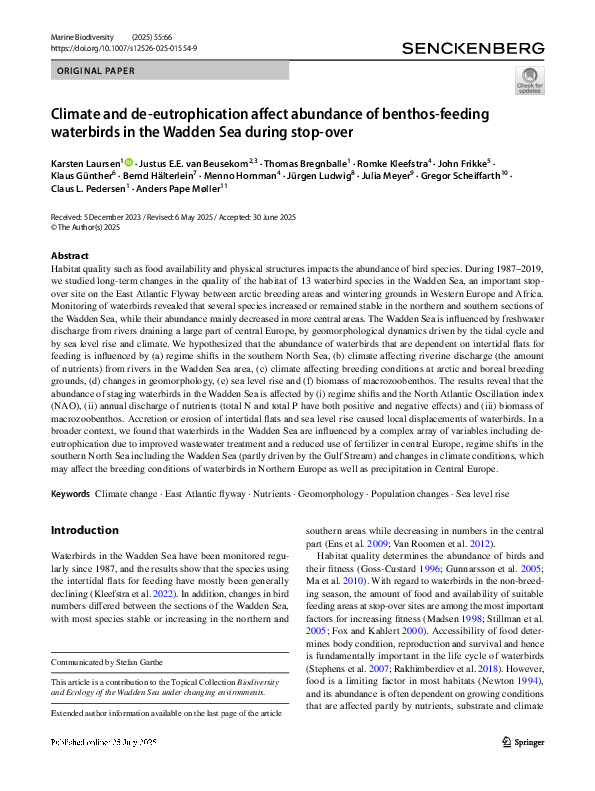Wetenschappelijk artikelClimate and de-eutrophication affect abundance of benthos-feeding waterbirds in the Wadden Sea during stop-over

Habitat quality such as food availability and physical structures impacts the abundance of bird species. During 1987–2019, we studied long-term changes in the quality of the habitat of 13 waterbird species in the Wadden Sea, an important stop-over site on the East Atlantic Flyway between arctic breeding areas and wintering grounds in Western Europe and Africa. Monitoring of waterbirds revealed that several species increased or remained stable in the northern and southern sections of the Wadden Sea, while their abundance mainly decreased in more central areas. The Wadden Sea is influenced by freshwater discharge from rivers draining a large part of central Europe, by geomorphological dynamics driven by the tidal cycle and by sea level rise and climate. We hypothesized that the abundance of waterbirds that are dependent on intertidal flats for feeding is influenced by (a) regime shifts in the southern North Sea, (b) climate affecting riverine discharge (the amount of nutrients) from rivers in the Wadden Sea area, (c) climate affecting breeding conditions at arctic and boreal breeding grounds, (d) changes in geomorphology, (e) sea level rise and (f) biomass of macrozoobenthos. The results reveal that the abundance of staging waterbirds in the Wadden Sea is affected by (i) regime shifts and the North Atlantic Oscillation index (NAO), (ii) annual discharge of nutrients (total N and total P have both positive and negative effects) and (iii) biomass of macrozoobenthos. Accretion or erosion of intertidal flats and sea level rise caused local displacements of waterbirds. In a broader context, we found that waterbirds in the Wadden Sea are influenced by a complex array of variables including de-eutrophication due to improved wastewater treatment and a reduced use of fertilizer in central Europe, regime shifts in the southern North Sea including the Wadden Sea (partly driven by the Gulf Stream) and changes in climate conditions, which may affect the breeding conditions of waterbirds in Northern Europe as well as precipitation in Central Europe.
- Bron
- Marine Biodiversity
- Jaargang
- 2025
- Aantal
- 55